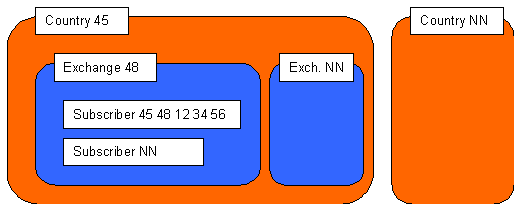![]()
![]()

New and updated informationCheck out new and updated information aboutGSM and 3G / UMTS here: |
A ususal household telephone is used almost soley to transfer speech. But some controlling information is transferred between the telephone and the exchange as well: status information such as whether the hook is on or off, whether a call is incoming (ie. the telephone rings), as well as the dialling information.
For a cellular phone, controlling the communication is much more difficult, as explained below.
Whereas the household telephone is connected to a specific plug, the exchange "knows" where it is. When someone is calling the first few digits of the telephone number indicates the exchange. In a typical danish telephone number such as 48 12 34 56, the first two digits indicates the exchange, and the last 6 digits indicates the subscriber within the exchange. When someone calls the number 48 12 34 56 the call is routed to exchange 48, which sends it through a wire to subscriber 12 34 56. This even works between different countries, where a county prefix is added. Denmarks prefix is 45, so if someone calls 00 45 48 12 34 56, the call is automatically routed to Denmark, and then to the exchange 48.
A given exchange therefore needs to know all it's subscribers (to be able to route incoming calls) and all exchange prefixes (to be able to route outgoing national calls), and all country prefixes (to be able to route outgoing international calls). In reality, the work of the exchange is even simpler, as international calls are often routed to a single international exchange etc.

For a cellular network, the situation is much more difficult, and the first question that comes to mind is: Where is the cellular phone?
When a cellular phone is switched on, it immediately contacts the nearest radio station to say "here I am". This is called a location update.The radio station relays this information to the nearest exchange, which stores the information. The radio stations are continually broadcasting a number of informations. The cellular phone always scans the different frequencies to receive this information. If the phone is moved, it can thus trace if it is nearer to a new radio station. Radio stations are grouped into so-called location areas (LA), and the information broadcasted includes the LA identification. If the cellular phone is moved to another area, where the radio station has a different LA, the phone contacts the radio station to say "now I am here". This location update is transferred to the nearest exchange.
Using the above scheme, the nearest exchange - the visitor exchange - always knows where the cellular phone is. When the cellular phone is switched on or sending a location update, the exchage sends this information to the so-called home exchange. This way, the home exchange always knows where the phone is.
The telephone number of the cellular phone indicates the home exchage. For example, a danish cellular phone may have the phone number 40 12 34 56. The prefix 40 indicates a specific home exchange. This echange will always know where the phone is.

| GSM Networks |
GSM Networks : Protocols, Terminology, and Implementation In depth technical reference, including advice on how to measure and test the interfaces. Buy it from Amazon.com |
| Or buy other GSM related books here | |
| [ Back to: GSM overview ] | [ home ] | [ Continue to: GSM sites ] |
Related GSM subjects:
[
Home
| GSM Index
| GSM Players
| GSM Entities
| GSM Phone as radio
| Digital speech coding
| GSM Call Control
| GSM sites
| GSM Radio Network
| GSM Coverage
| GSM Network System
| Buy GSM books
| Buy GSM equipment
| GSM Links
]
| Check this out: |
| [ Books, Music, Videos | Best of Pokemon | MP3 uncovered ] |
| [ Make cheap phonecalls using the internet ] |

|
Page created by Henrik Kaare Poulsen.
You can drop me a mail or sign my guestbook Page hosted by Yahoo! GeoCities |
|